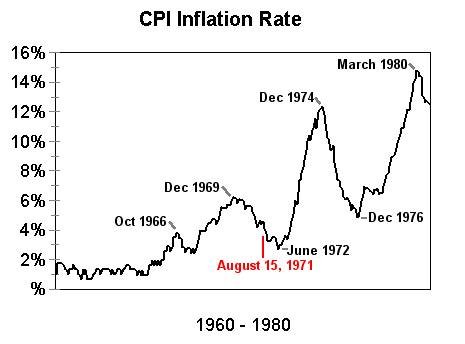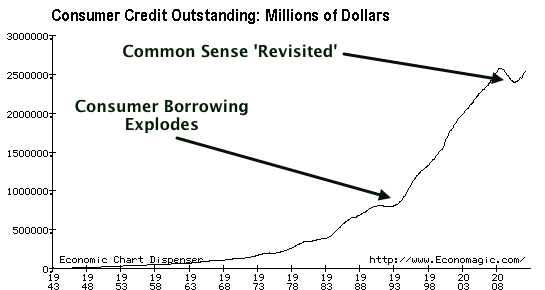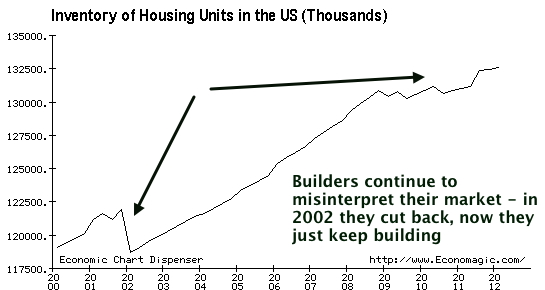Hiding Inflation Results in Perma-Recession, The Next Great Keynesian Failure
Economics / Great Depression II Jul 02, 2012 - 01:47 PM GMTBy: Andy_Sutton
 As we enter Round 15, give or take a couple, of the heavyweight battle between economic laws and the (not so) Great Keynesian experiment at Normandy and elsewhere in Euroland, one must really begin to wonder what exactly the outcome will be in social terms. There is one point in the entire goings on that has been mentioned by several other analysts in covering the big picture of what ails the financial world that needs more attention and that is aggregate demand. We’re also going to take a look at some of the other tools that have been used in the past to ‘hide’ the effects of rampant monetary inflation, namely the deindustrialization of America and the rise of consumer credit.
As we enter Round 15, give or take a couple, of the heavyweight battle between economic laws and the (not so) Great Keynesian experiment at Normandy and elsewhere in Euroland, one must really begin to wonder what exactly the outcome will be in social terms. There is one point in the entire goings on that has been mentioned by several other analysts in covering the big picture of what ails the financial world that needs more attention and that is aggregate demand. We’re also going to take a look at some of the other tools that have been used in the past to ‘hide’ the effects of rampant monetary inflation, namely the deindustrialization of America and the rise of consumer credit.
The point needs to be made at the outset that this is by no means a comprehensive list of all the factors involved in this multi-pronged issue. In reality, each of these sections could easily become a dissertation given the complexity of the issues involved.
Multiple Ways to Attack the Effects of Monetary Inflation
In the 1970s, most who were above the age of 15 or so at the time will remember the price controls that were put into effect to stem the tide of the first bolus of monetary inflation ex poste the Gold Standard. The same day Nixon ended the link between the USDollar and gold, he also imposed a series of price and wage controls thinking that enforcing such an action would maintain the social status quo. Herein lies the truth of the matter. It has long been asserted that inflation is merely a price phenomenon and that mainline politicians and the Proletariat simply don’t understand economics. Nixon and his advisers knew better, however, and the price controls are prima facie evidence of that. The US had been decoupling from gold and it was widely known that Bretton Woods was not long for the world. The monetary pumps had been started, as was the plan all along, with the federal reserve firmly in control of monetary policy for nearly 60 years at that time.

Despite the fact that America was on a gold standard from 1913 through 1971, the fed had already managed to destroy around 25% of the dollar’s purchasing power. They all knew very well, however, that once the link to gold was cut and the new paradigm of fiat money became better understood that prices for final goods were going to take off because of the influx of now intrinsically worthless paper notes. Hence Nixon’s imposition of the price and wage controls, which initially, were supposed to last 90 days. So utterly disastrous of a failure were the price controls that one phase turned into four and lasted a grand total of over 1000 days. The idea of using price controls was a foolish one as even the Keynesians realize that if you set the price below equilibrium you’re going to end up with shortages. And that is precisely what happened. The price controls were mostly dismantled by 1974.
To understand why all of this took place, it is essential to first understand the desired outcome, which was and has always been a worthless dollar. Think about it as a slow-motion bank robbery. If you have an extremely wealthy country, as the US was post WWII, you can’t just go in and re-possess everything; that would raise the ire of the citizenry. But what you can do is impose incremental changes that over the course of decades slowly rob the citizenry of its wealth. Look at the dollar as a prime example. Even under the auspices of a (weak) gold standard, the fed was able to steal 25% of the dollar’s purchasing power between 1913 and 1971. Compare that with today and you’ll find that the fed has now managed to steal 95.4% of the dollar’s purchasing power compared to 1913. That is a pretty crafty theft, no? And if you really think about it, public awareness of this robbery was near zero until just a couple of years ago.
New Modus Operandi for a New Paradigm
Obviously the price controls weren’t going to work in terms of hiding the inflation that makes the dollar go down in value. But before we even go there, we need to explain exactly HOW printing more dollars makes existing ones worth less (and eventually worthless, no pun intended). Think of yourself in a desert, in dire need of water. You find a container of water. It is extremely valuable to you. You guzzle it down and are satisfied. A few minutes later you find another container, then another, and another. Each additional container of water becomes worth a little bit less than the container before it. This is a manifestation of the law of marginal utility. Applying that to the dollar, the value of each new fiat dollar that goes into circulation is worth just a little less than the one before it.
This creates an undesirable situation socially. The power structure learned very quickly that there are huge social dislocations when ‘inflation’ gets above around 5%. The 9% inflation of 1974 was socially intolerable. There was no way the dollar could be devalued in such a way that a 9% CPI was going to result. The inflation had to be hidden.
The De-Industrialization of America
While there is no precise or specific date that the de-industrialization of this country started, it is clear the process began in the 1970s. Most of the goods at that time were made in America and, by and large, were of good quality. We imported things too, but those were generally luxury-type items like jewelry and expensive designer clothing, among other things. One would typically deduce (and properly) that a weak dollar should have been good for American exports. However, the ‘benefits’ of the weak dollar were greatly overcome by several other factors, perhaps the most important being a lack of investment.
From the 1960s through the end of the 1970s no less than 3.3% of the national income was invested in heavy industry such as factories and equipment in any given year. However, beginning in 1980 and moving forward, such investment never even reached 3%. Simply put, we stopped investing in our heavy industry. This was perhaps the most apparent in the steel industry as our American steelmakers tried to compete with foreign firms who benefitted from updated equipment compared with our ancient technology. Some of this lack of investment could certainly be attributed to the weaker dollar; however, government was an important player in handicapping American firms versus foreign counterparts. The General Agreement on Tariffs and Trade (GATT), which was implemented in 1947 and lasted until 1993, was perhaps the biggest dagger in the heart of American industry as it removed much of America’s competitive advantage in manufacturing and exports. Henceforth from 1993, it got even worse with the World Trade Organization (WTO) taking over the reins of the deindustrialization. The implied intention of GATT/WTO was to bring foreign countries up to the same living standards as those of Americans. In reality, the stated intention was to lower American living standards to that of the rest of the world.
So how did the deindustrialization of America hide monetary mischief? Simple. The goods that used to be made here were now brought in from foreign countries, which had lower purchasing power parity levels, and as a result their goods cost less. The biggest of their advantages were labor cost and depending on what type of good you’re dealing with, labor can be a significant portion of the total cost of the product.
This method of hiding inflation persists to this day as most of our consumer goods come from Asia where labor costs are comparatively lower and there are little in the way of regulatory costs. These lower costs for goods made the decline in the value of the dollar less apparent to Americans because it allowed their wages to go a little further. One might ask why this was not a sustainable path for the long term and the answer is simple. Relying on imports creates current account deficits because money is going out of the country for the imported goods, but not enough money is coming back into the country from the sale of exports. That condition STILL exists today. Here are some quick 2010 ‘facts’ about the great deindustrialization:
- The United States has lost approx. 42,400 factories just since 2001.
- 1.2 Billion cell phones were sold in 2008. None were made in the US.
- The US has lost 5.5 million manufacturing jobs since 2000.
- Manufacturing represented 28% of US economic output in 1959. In 2008? 11.5%.
- Mfg. employment in the US computer industry was lower in 2010 than in 1975.
The Emergence of Consumer Credit
This is one area where the American people are the most responsible for their own destiny and the words henceforth are liable to sting in many cases, but these things need to be said in order that we all gain a better understanding of what is really going on and how the various tools are being used to steal the wealth of the United States. Those of you readers who were alive in the 1960s will know full well what I’m talking about. There was no such thing as consumer credit by and large. There were no credit cards and even most cars were bought with cash – or at least a very substantial down payment. The one piece of debt the average family had was a mortgage and even then banks required large down payments and only the most creditworthy of individuals were approved.
However, by the 1980s it was becoming readily apparent that the deindustrialization of America wasn’t going to be enough to hide the money printing that was going on, not to mention the debt that was starting to accumulate. It took this nation over 200 years to accumulate its first trillion in national debt and barely 25 years to accumulate another $15 trillion, not to mention the underlying unfunded liabilities. Clearly another tool was going to be necessary and this one was a beauty, complete with a Madison Avenue marketing snow job on the American public. The 1980s featured the advent of store credit, ’90 days same as cash’, and other credit facility type arrangements such as home equity loans – then called second mortgages. In the latter half of the 1980’s, the credit card became mainstream. It differed from the store card in that it could be accepted at any location that was a member of that card’s network.
Putting things on a timeline, we’ve begun to deindustrialize America, sent a second breadwinner into the workforce in many households and that still wasn’t enough. Consequently, we had to provide people with a way to borrow money in a manner that was so easy that they’d come to rely on it to bridge the gap between their wages and their costs as well as between their needs and wants. The vampire squids in the banking establishment were more than willing to oblige as was Madison Avenue and the advertising and promotion blitz was underway.
Ironically, around the same time as GATT switched to the WTO, although there is no real link, consumer credit began to skyrocket (see graphic below). Americans were now inculcated to the idea of ‘buying on time’ and the race was on both in terms of gross materialism as well as the devaluation of the dollar. Much like the deindustrialization, the consumer credit phase is ongoing even to this day, save for a brief hiccup between late 2009 and late 2010 that sent shockwaves through the central banking establishment.

The Attack on Aggregate Demand
We’ve now reached 2009 and a recession has already raged for three years by honest measurements, brought on by many things, the most important of which was NOT the residential real-estate problem, rather it was a further eroding wage base even with all the aforementioned tools firmly in use. Price inflation ran away from 2003 -2006 while wages remained fairly stagnant. Consumers were borrowing heavily at this point on credit cards, home equity loans, student loans, cash out refinance deals and auto loans and things reached a bit of a critical mass. The securitization of mortgage bonds and the resultant derivative bets triggered a financial crisis, but not an economic one. Once again, the laws of economics were ignored and things got to the point where even the most insane of consumers began to get worried. In a display of typical American largesse and ignorance, luxury homebuilders continued developing real estate even when all the signs were there that the wage and even borrowing base of the market couldn’t support higher prices. Debt loads were (and still are) way too high and when your economy is 70% depending on consumer spending for its growth, you’ve got a problem when that spending slows down.
Many of you have emailed and/or wondered aloud why the fed and government have been engaging in such obviously ridiculous policy these past several years. Whether it is the TARP debacle, the ‘shovel-ready’ jobs stimulus of 2009, something of a bailout for homeowners who were burned by purchasing at the top of the market, Fannie, Freddie, or any number of other absurdities, the motive should now be apparent. They are attacking aggregate demand as a means of hiding the destruction of the dollar. The ridiculous dollar index doesn’t help either, as every time a new phase of the Eurozone crisis kicks off, the USDollar appears to gain ‘strength’.
This is why nobody really seems to be all that concerned about the shrinking labor force, the near total lack of job creation, and other economic anomalies that are totally inconsistent with a recovery. Businesses don't mind if you cut their taxes, but if you want them to hire more workers then aggregate demand must be increased and absolutely NOTHING is being done to encourage a genuine increase in demand. Borrowing money, especially at the consumer level, to consume can only last so long and it is already clear that the consumer credit locomotive is simply the little engine that couldn’t.

A few weeks ago a Toll Brothers executive made a statement that is probably the most disconnected from reality as one could possibly get. He feels that there is ‘four years of pent up demand’ for luxury homes and that the fed with its operation TWIST is going to unleash all that demand on the market. If you listen to this guy, there are millions of people out there who just can’t wait to sign on the dotted line for a mortgage that is likely to be underwater before the ink is dry just because rates drop another half percent. Maybe he’s right. If he is, then this insanity could very well continue for quite a while longer.
Hiding inflation is the same reason the banks have been unleashing a coordinated (but losing) battle against both gold and silver. Gold and silver are to fiat money what sunlight is to a vampire. Given this reality, it is very likely that this recession that already seems to have gone on forever, is likely to become a perma-recession; at least until the dollar finally reaches its predestined resting place in the trashcan of history along with every other fiat monetary experiment.
By Andy Sutton
http://www.my2centsonline.com
Andy Sutton holds a MBA with Honors in Economics from Moravian College and is a member of Omicron Delta Epsilon International Honor Society in Economics. His firm, Sutton & Associates, LLC currently provides financial planning services to a growing book of clients using a conservative approach aimed at accumulating high quality, income producing assets while providing protection against a falling dollar. For more information visit www.suttonfinance.net
Andy Sutton Archive |
© 2005-2022 http://www.MarketOracle.co.uk - The Market Oracle is a FREE Daily Financial Markets Analysis & Forecasting online publication.



